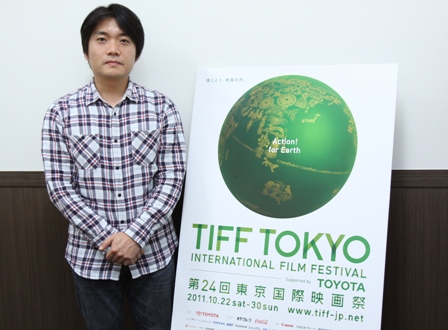Japanese Eyes “A Song I Remember” Interview with Kyoshi Sugita (Producer/Director/Screenplay)
Most people will agree that films rarely reflect real life, and they probably prefer it that way. To many, films are a means of escaping everyday life, so the less similarity the better. Kyoshi Sugita doesn’t necessarily disagree with this credo, but his approach to filmmaking is almost the opposite. In trying to explain the unique narrative style of his debut feature, “A Song I Remember,” he says he is less interested in story or visuals than in the manipulation of time. When asked to explain, however, he can only fall back on an example from the film itself.

“There is one scene that takes place at night on a train platform,” he says. “The woman says to the man that there’s a place she wants to go to, and the moment she says that the air trembles, and while the space between them doesn’t change physically, their sense of time does.” A train then arrives and the scene changes, which means the timeframe changes as well. What Sugita seems to want to say is that each scene has its own unique feel for the moment and it is his desire to convey that feeling as accurately as he can. The problem is that events occur between scenes that we don’t see, and much of life is filling in details we don’t experience directly in order to make sense of what we do see and hear and feel.
So while “A Song I Remember” does have a story, and a fairly conventional one, many of the central events of that story aren’t shown, because in real life it’s impossible to experience every event that makes up a story. The main character, Takeshi (Takenori Kaneko), is a quiet, introverted young man whose hobby–some might call it an obsession–is to take Polaroid pictures of people in candid, natural settings, preferably without their knowing it. One day on a train platform he photographs a woman reading a book, and later this woman dies. Eventually, Takeshi develops a relationship with the dead woman’s daughter, Toko (Yuri Ishizaka), without telling her he saw her mother just before she died. That is the story in a nutshell, though many viewers may not be able to draw even that much information without watching the movie at least twice because Sugita only shows them what happens between the story’s most dramatic events.
Consequently, the film often seems to wander off randomly. In one scene, Takeshi follows a man in a pink T-shirt home and then photographs him just as he is about to enter his house, and the man seems to notice. Actually, this scene is central to the story. “Takeshi feels some sort of affinity for the guy in the pink shirt,” Sugita explains. “And while he didn’t see the accident where the woman died, he suspects it may not have been an accident and that the guy in the pink shirt may have been involved. That’s why he followed him.”

Sugita goes on to say that one character in the movie commits suicide but that most viewers probably won’t realize it because the clues are so subtle as to be almost non-existent. “So far, about one in twenty people have noticed them,” he says.
Movie directors are often compared to gods in that they manipulate whole worlds, and Sugita says that he made time charts of the characters’ lives when writing the script. “But I didn’t show them to the actors,” he says. “When we meet people in real life we only know the surface of that person. We never understand things totally, and I wanted my movie to convey that. All the characters should be enigmatic.” In a sense, his leaving out many of the central dramatic scenes is an expression of respect for the characters, since they are “private moments.” In other words, they are none of his business.
The film’s narrative style also reflects Takeshi’s tentative temperament. A gardener by trade, he doesn’t need to interact with people to make money, and in one scene a customer brings him and his partner refreshment and tries to make small talk. Takeshi is polite but reticent, and one of Sugita’s aims is to show how people who aren’t conventionally communicative―meaning through speech―can get their feelings across by other means. “I often meet people who can’t communicate and still send out some kind of message even though they’re quiet.”

For Takeshi, photography is one means of communication, which is why the Polaroids are important. “Takeshi is not a photographer,” Sugita explains. “And in order for him to use regular film he would have to deal with somebody in a store to develop and print them, something he’s incapable of.” Polaroids give him the physical evidence he desires without having to rely on somebody else to provide it.
It’s odd then that Sugita doesn’t actually show any of these photos on screen until the very end, and even then he shows only one. “A photo already has a frame,” he says. “So if you put another frame around it using a movie camera, the picture turns into a real photograph on the screen.” As to whether or not this is undesirable, he doesn’t say, but in any case Sugita hopes that when the film is finally released theatrically he can hold an exhibition at the same time of the Polaroids that Takeshi took, which will include those that cover his life after the time frame described by the film. Usually, audiences don’t think of movie characters’ lives extending beyond “The End,” but Sugita does, because life goes on even after a dramatic series of events. “Those are the things I like to think about,” he says.
Interviewed by Philip Brasor (Film writer)
A Song I Remember












